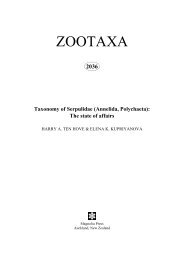Create successful ePaper yourself
Turn your PDF publications into a flip-book with our unique Google optimized e-Paper software.
own tomentose, sparsely to densely covered with long, straight or sinuous, briefly swollen-based,<br />
diagonally or vertically oriented spines, these flattened or triangular in cross-section, whitish-brown<br />
proximally, black or brown distally, with tomentose margins (rarely without spines), or peduncular bracts<br />
broad, the surfaces ridged, brown tomentose, sparsely to densely covered with short, recurved, markedly<br />
swollen-based, diagonally oriented spines, these triangular in cross-section, whitish-brown proximally, brown<br />
distally, with tomentose margins (rarely without spines), or peduncular bracts narrow, elongate, ribbed,<br />
scarcely brown tomentose, without spines (rarely with few spines), or peduncular bracts broad, ridged,<br />
densely covered with short, straight, swollen-based, vertically oriented spines, these terete, whitish-brown<br />
proximally, brown distally, without tomentum, or peduncular bracts broad, ribbed, densely brown tomentose,<br />
without spines (very rarely with a few spines), or; peduncular bracts broad, ribbed or ridged, densely covered<br />
with felty, reddish-brown tomentum, sparsely covered with short, scarcely swollen-based, diagonally<br />
oriented, flattened spines, whitish-brown proximally, brown distally, with tomentose margins, or peduncular<br />
bracts broad, ribbed with several more prominent, lighter colored ribs, brown, scarcely or not tomentose,<br />
without spines (rarely with a few spines), or peduncular bracts narrow, ribbed, densely whitish-brown<br />
tomentose, not spiny, or peduncular bracts broad, the surfaces ribbed or ridged, brown tomentose or glabrous,<br />
sparsely to moderately covered with short, straight or sinuous, briefly swollen-based, diagonally or vertically<br />
oriented spines, these flattened or triangular in cross-section, whitish-brown proximally, black or brown<br />
distally, with tomentose margins, or peduncular bracts broad, the surfaces deeply ridged, dark brown<br />
tomentose, sparsely covered with long, straight or sinuous spines, the bases scarcely swollen but running<br />
directly into the ridges of the bract and lying flat against the bract surface, flattened in cross-section, brown<br />
proximally and distally, with tomentose margins; rachillae brown tomentose initially, or rachillae glabrous or<br />
scarcely tomentose initially; stamens five to seven, or stamens eight to 12; fruit surfaces uneven with<br />
numerous, subepidermal, short, often branching (Y-shaped) fibers, or fruit surfaces smooth, without any<br />
apparent subepidermal fibers, or fruit surfaces uneven with numerous, subepidermal, long, branching fibers,<br />
or fruit surfaces bumpy from numerous, subepidermal, short, oblique fibers; fruiting corollas less than one<br />
quarter as long as fruits, or fruiting corollas to half as long as fruits; fruiting corollas splitting irregularly into<br />
3 lobes, the lobes often splitting again, or fruiting corollas not or scarcely splitting, tending to remain cupular;<br />
endocarps globose to obovoid with rounded or slightly peaked apices, the pores lateral, or endocarps narrowly<br />
ellipsoid with rounded apices, the pores lateral, or endocarps broadly obovoid with flattened apices, the pores<br />
lateral on or near flattened apices, or endocarps ovoid to obovoid with prominent, peaked apices, the pores<br />
lateral.<br />
Key to the species of Desmoncus<br />
1 Mexico and Central America ...................................................................................................................................... 2<br />
- South America, Trinidad and Tobago, and the Lesser Antilles .................................................................................. 10<br />
2 Pinnae with long, filiform apices; cirri absent, the rachis terminating beyond the distalmost, opposite pair of pinnae<br />
in a
















